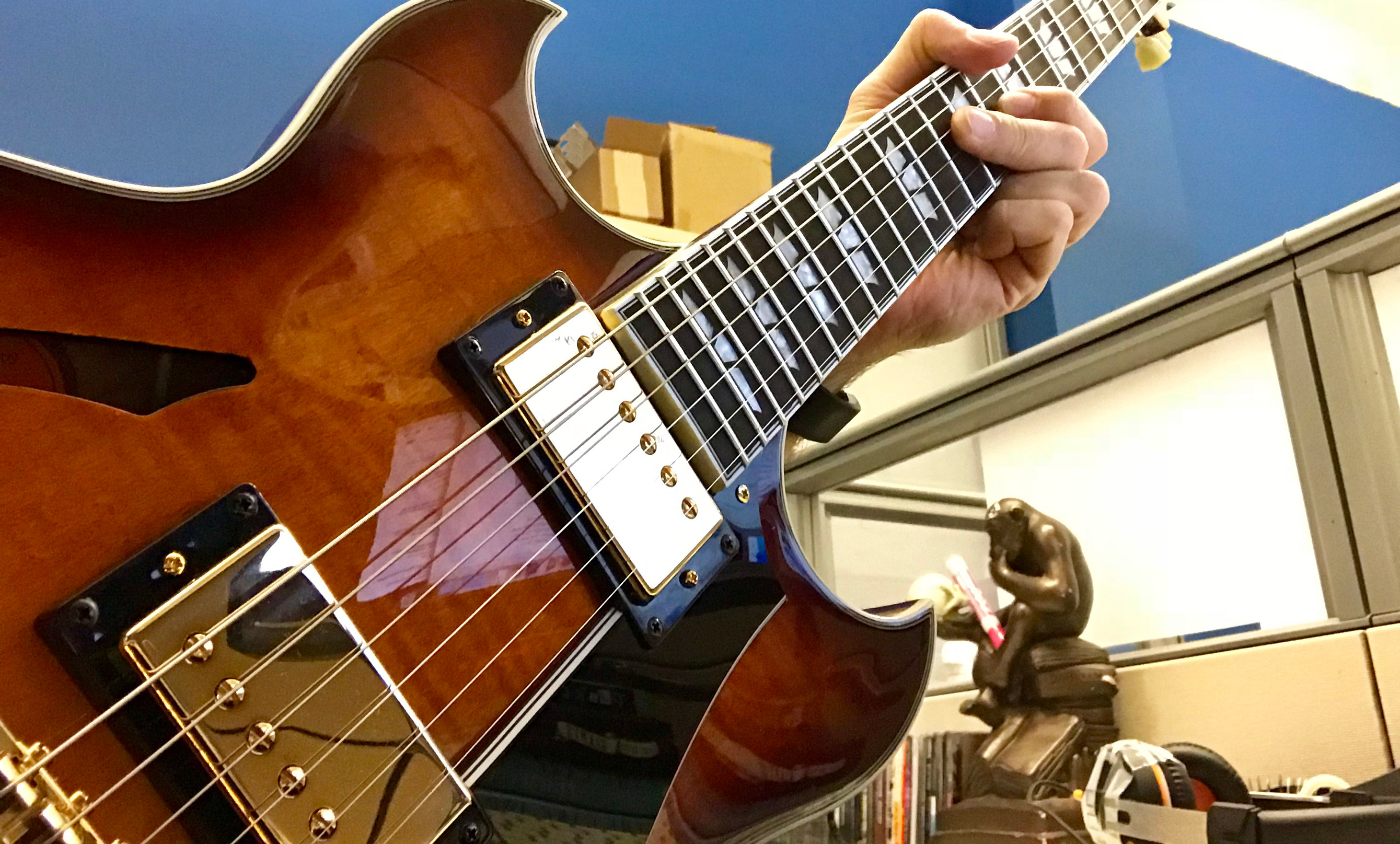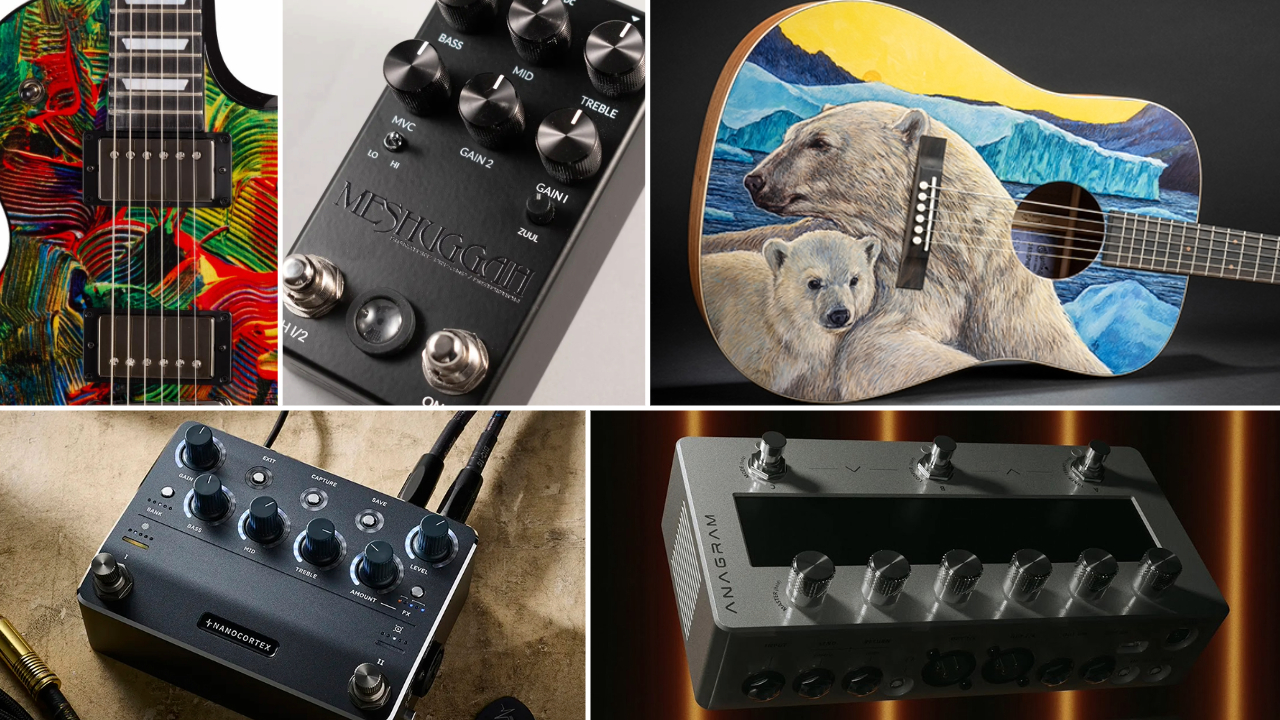Beyond the Octave — Upper Structure Triads for Jazz Guitar

When learning how to play jazz guitar, one of the most commonly asked questions is, “How do I add chord extensions to my soloing ideas?” To help answer this question, in this lesson we’ll be looking at an easy, fun and effective way to bring extension notes into your jazz guitar solos — upper structure triads.
What Are Upper Structure Triads?
To begin, let’s take a look at what exactly upper structure triads are and how you can apply them to your jazz guitar soloing ideas. Upper structure triads are three-note chords — triads — that use the notes beyond the root-3-5-7 arpeggio structure of any chord.
This means they use the 9th, 11th and 13th notes of any chord, which are the 2nd, 4th and 6th notes, but up one octave to be placed above the underlying arpeggio shape.
Here is an example of a C major scale written out in scale form, first two bars, followed by the arpeggio and upper structure triad for that chord. When you build upper structure triads, you can label them as you would any triad.
This means that in the case of Cmaj7, you can play a Dm triad (D F A or 9 11 13) over a Cmaj7 chord to outline all of those sounds in your playing.
You can apply Upper Structure Triads to any chord that you are soloing over in a jazz context, not just the maj7 chord in the first example.

In this lesson we’ll be looking at applying upper structure triads to the I VI ii V chord progression. To help you understand the triads that work over each of these chords, here they are in the key of C to study and practice from a technical standpoint before moving on to the licks in the lesson below.
Cmaj7 – Dm
A7b9 – Bbdim
Dm7 – Em
G7 – Am
Or, to think of it as Roman numerals, in order to make things easily transposable to other keys, here are the numerals for each chord and upper triad.
Imaj7 – ii
VI7b9 – biidim
iim7 – ii
V7 – ii
A good exercise to get these sounds under your fingers is to play the original arpeggio followed by the upper structure triad for each of these chords in different parts of the fretboard, and in different keys as you solidify this concept in your ears and under your fingers in your practice routine.
Upper Structure Lick 1
Here's a sample lick that will help you hear and apply the sound of upper structure triads to a I VI ii V chord progression, which is commonly found in countless jazz tunes from the classic repertoire.
When you’ve worked this lick out on the neck, try writing out three to five licks of your own that use upper structure triads as the basis for your lines, moving on to applying these ideas to other progressions beyond I VI ii V as well in your woodshedding.

As is the case with any lick you learn, work this phase in the key of C before moving it around to the other 11 keys on the fretboard. Also, try soloing over a tune you know or are working out in the practice room and use this idea over various sections of that tune where the chords apply.
Lydian and Lydian Dominant Triads
When soloing in a jazz context, many players prefer the sound of a #11 to a natural 11 when playing over maj7 and 7th chords. This is due to the 3rd and 11th of those chords being a half-step apart, causing a bit of tension when playing the 11th over the 3rd in a soloing context.
To avoid this dissonance, you can use upper structure triads to build #11 sounds over both maj7 and 7th chords in your soloing phrases. Here is how you would do that over both a Cmaj7 and G7 chord.
Cmaj7 – D
G7 – A
Or, written as Roman numerals, these chords and upper triads would be:
Imaj7 – II
V7 – II
Meaning that if you have a Imaj7 chord, you can play a major triad from the second note of that chord to produce the maj7#11 sound. Same goes for the V7 chord, where you play a major triad from the second note of that chord to produce a 7#11 sound.
Once you have worked out the theory behind these #11 sounds, try working them out on the fretboard, and then bringing them to your soloing phrases when improvising in order to expand upon them in your jazz guitar practice routine.
Upper Structure Lick 2
To help you get the maj7#11 and 7#11 sounds into your playing using upper structure triads, here is the same lick that you just learned in the previous section, with the 11ths being raised to #11s over the Cmaj7 and G7 chords.
Work this lick out in the woodshed, and then try and write out 3 to 5 licks of your own that use maj7#11 and 7#11 upper structure triads to build your lines.

Once you have this lick under your fingers in the key of C major, try taking it to other keys and applying it to tunes you know or are working on in the woodshed.
Upper structure triads are fairly simple to get under your fingers, as they’re based on three-note shapes, but as you can see, they can expand your soloing chops and provide new colors to your jazz guitar soloing lines and phrases.
Do you have a question about upper structure triads? Share your thoughts in the COMMENTS section below!
Matt Warnock is the owner of mattwarnockguitar.com, a free website that provides hundreds of lessons and resources designed to help guitarists of all experience levels meet their practice and performance goals. Matt lives in the UK, where he is a lecturer in Popular Music Performance at the University of Chester and an examiner for the London College of Music (Registry of Guitar Tutors).
Get The Pick Newsletter
All the latest guitar news, interviews, lessons, reviews, deals and more, direct to your inbox!
Matt Warnock is the owner of mattwarnockguitar.com, a free website that provides hundreds of lessons and resources designed to help guitarists of all experience levels meet their practice and performance goals. Matt lives in the UK, where he teaches Skype guitar students all over the world, and is an examiner for the London College of Music (Registry of Guitar Tutors).










